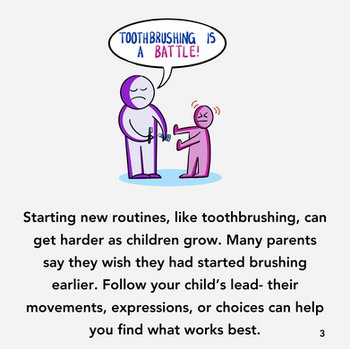
Making brushing fun
Overview
There are many ways to make toothbrushing a fun experience. Every autistic child is unique, so what works for one child may not work for another. It’s important to be patient and keep trying different methods to find what works with your child and what they are comfortable with, to ensure they're not overwhelmed or distressed by the experience.
Some parents like to introduce toothbrushing as part of playtime. Other parents have found turning toothbrushing into a game, and using rewards like stickers or praise helpful. This page provides an overview of toothbrushing apps and songs which some may find helpful.
Sensory preparation
Balancing the sensory system before toothbrushing helps children feel more comfortable and more ready to take part and learn. This can help make the experience less overwhelming and more enjoyable. Help your child prepare their body and mind by doing a few minutes of regulating activities that includes a lot of 'heavy work' - movements that need effort from their muscles and joints. You can find some ideas for activities and breathing here. You may also find it useful to include 1-2 activities that create calming deep pressure around the mouth. These can also regulate breathing which can help to lower heart rate and stress levels. Below are some examples:
-
If your child uses a chew tool, you can let them chew on this before brushing.
-
You can play a gentle teeth ‘tug of war’ with a clean washcloth. Please avoid this activity if they have wobbly teeth.
-
You could press the outside of your child’s face with the pads of index and middle fingers over the section of teeth you are going to brush next.
-
You can massage the outer gums with 1-3 sweeps of the pad of finger and thumb or a washcloth.
-
Using moderate pressure, use the handle of a vibrating toothbrush or toy to press along the jawline.
-
You can try a face massage.
Oral motor games
-
Blowing bubbles
-
Blowing a pin wheel round
-
Blowing bubbles into water with a straw
-
Blowing a pom pom or cotton wool ball towards a goal or between you both across a table or on the floor
-
Making exaggerated animal faces
-
Puffing up cheeks and pop them, or experiment with blowing raspberries
-
Smacking the lips or make popping noises with the mouth
-
If neither of you are sound sensitive, try whistles, bird whistles, kazoos and whizzy lips
-
Sucking water up through a straw or bendy straw or have a drink from a sports bottle or beaker that needs pressure and lips closed around the spout to activate the flow
Downloadable resources
Apps
The use of apps depends on your child and how this may fit in with your toothbrushing routine. Find out more about apps here.
Praising, stickers and rewards
It’s important to notice and celebrate every small win with toothbrushing. Saying “well done,” giving a sticker, or a small reward can help keep your child motivated. You could use a chart to track brushing and add gold stars each time it’s done. At the end of the week, if they reach the goal, you could play their favourite game as a fun reward.
Letting your child choose the toothbrush/toothpaste they use
When we spoke with children, they described the colour of their toothbrush and toothpaste, what it looks like and what it smells like. This showed us that these things were important to them. If your child is able, you can get them to choose their toothbrush or toothpaste that gets them excited about brushing. There are lots of brands out there that have different design, colours and even their favourite characters.
The linked pages provide you with an overview of different toothbrushes and toothpaste that may help with your children’s preferences and sensory needs.

Using a mirror
Some parents have found it useful to use a mirror when brushing to make it more engaging. Children that we spoke with also found that a mirror was useful, so they found it helpful to watch their mouth movements and see where their toothbrush was reaching. It is possible to purchase acrylic mirrors with suction cups that can be helpful if you find that brushing in the bath works best for your child.
This can also be useful at the dentist. Find out other ways you can support your child at the dentist here.
Watching others
Parents/caregivers play an important role in looking after their children’s teeth and gums. Children often learn through observation. As a parent, showing your child how you brush and take care of your teeth can be a powerful way to encourage them to adopt similar habits. Some children respond well to watching a sibling or parent brushing their teeth. This is called ‘modelling’. You could consider making a video of a family member brushing their teeth which your child can then watch on repeat. It is important to make sure that whoever you film is using the correct technique
Key messages






